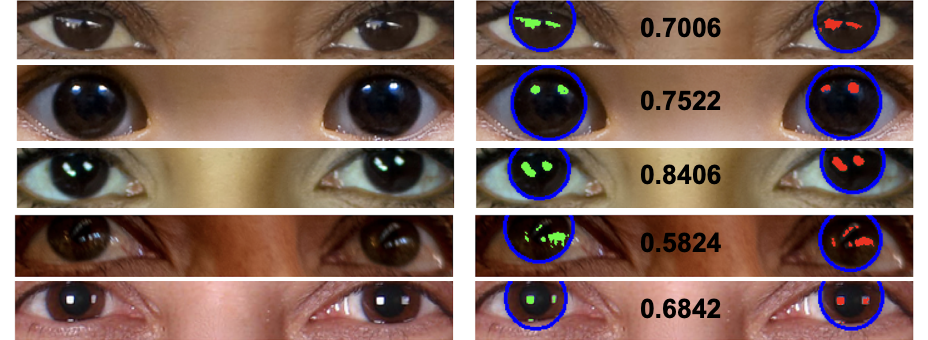EXPOSING GAN-GENERATED FACES USING INCONSISTENT CORNEAL SPECULAR HIGHLIGHTS
Shu Hu, Yuezun Li
, and Siwei Lyu
Department of Computer Science and Engineering
University at Buffalo, State University of New York, USA
Paper
Blog
Code

Figure 1: The corneal specular highlights for the real face have strong similarities while those for the GAN-synthesized face are different.
News
This work has been mentioned by Financial Times and usa-visionCitation
@article{hu2020exposing,
title = {Exposing GAN-generated Faces Using Inconsistent Corneal Specular Highlights},
author = {Hu, Shu and Li, Yuezun and Lyu, Siwei},
journal = {arXiv preprint arXiv:2009.11924},
year = {2020}}
What is New?
Sophisticated generative adversary network (GAN) models are now able to synthesize highly realistic human faces that are difficult to discern from real ones visually. GAN synthesized faces have become a new form of online disinformation. In this work, we show that GAN synthesized faces can be exposed with the inconsistent corneal specular highlights between two eyes. We show that such artifacts exist widely and further describe a method to extract and compare corneal specular highlights from two eyes. Qualitative and quantitative evaluations of our method suggest its simplicity and effectiveness in distinguishing GAN synthesized faces.
Let's Play a Game!
Does these faces real or fake?
(Click the face to get the answer)


Pipeline

Figure 2: Overall process to obtain corneal specular highlight. (a) The input high-resolution face image. (b) Detection of facial landmarks around the eyes. (c) Hough circle detection of the corneal area. (d) Intersection of the eye region and circular corneal region. (e) Extracted corneal specular highlight area.
Corneal Specular Highlights

Images of real human eyes.

Images of GAN synthesized human eyes.
Figure 3: Corneal specular highlights from real human eyes (top) and GAN generated human faces (bottom). The right column corresponds to the detected corneal region (blue) and the specular highlights of two eyes (green and red). The IoU scores of the two corneal specular highlights are shown alongside the detections.
Distributions of IoU Score

Figure 4: Distributions of the IoU scores between the detected corneal specular highlights of two eyes for real and GAN synthesized faces.